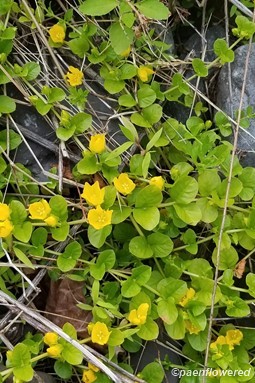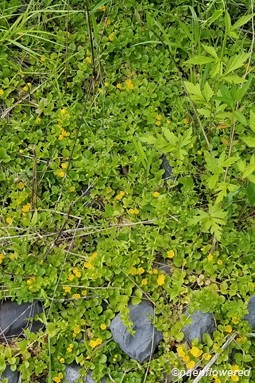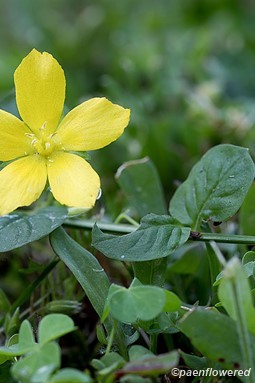Lysimachia nummularia
A creeping, mat-forming loosestrife from Europe
Lysimachia nummularia moneywort
This perennial, evergreen, trailing or creeping vine-like plant was introduced from Europe and has naturalized throughout the United States primarily in the northeast. The species is documented in most counties in Pennsylvania. It is a member of the primrose family. It has small, round, shining leaves that occur in pairs. Each leaf is ½ to 1 inch in diameter. The stems may be up to 24 inches long.
The species name is derived from the Latin word "nummus" that means coin and is also reflected by its common name moneywort. This is a reference to the round shape of the leaves of this plant that have the shape and size of coins. Beginning in June this plant produces yellow flowers with five petals on slender stalks. These flowers vary in size from ½ to 1 inch and are found singly or in pairs growing from the leaf axils. There are five petals often dotted with dark red. There are also five stamens.
The plant grows in moist grasslands, lawns, and roadsides, preferring areas of partial shade. Although vine-like it does not climb. It takes well to cultivation and can be planted in both rock gardens and in hanging baskets that are drier than its normal wild habitat. It can, however, spread aggressively, frequently forming new roots from the prostrate stems. It is cold-tolerant, surviving winter temperatures down to -40 degrees F.
Traditionally the plant was used as a herbal treatment for wound healing and for kidney and gall stones. Some still use it today as a gout treatment. The science behind these claims is less certain.
Habitat & Range
Common weed of lawns, meadows, wet woods and flood plains.
Present throughout the state.
Range: From Newfoundland south to Georgia, west to Missouri and Kansas, and on Pacific coast
| EMP: | FACW |
|---|---|
| NCNE: | FACW |
Phenology
Flowers late May through October.
Characteristics
Flowers yellow dotted with dark red; 5 petals; solitary in the leaf axils; ¾ to 1¼ inches across
Leaves opposte, small, glossy, oval to nearly round; on short petioles; ½ to 1 inch wide
Stems trailing on the ground, up to 5 feet
Height N/A
Identification Tips
Round, glossy pairs of leaves are reminiscent of coins.
Medicinal Qualities
Moneywort is traditionally known as an astringent and can be used in healing of minor external wounds.















Comments
Have you spotted this plant in your area? We'd love to hear about your experience! Share your comments or questions about the plant below. Comments are moderated before posting.